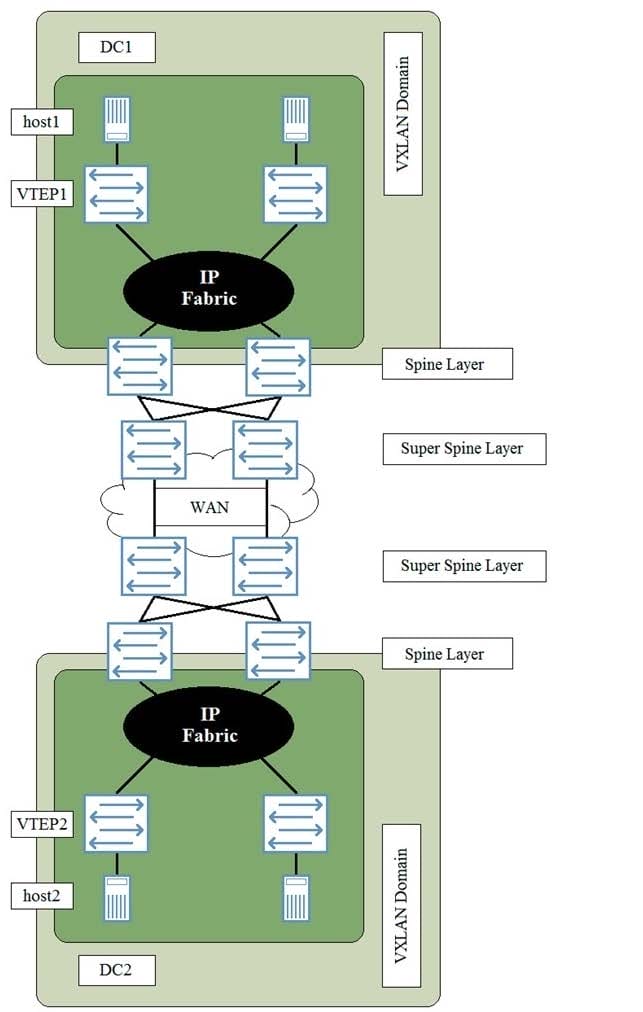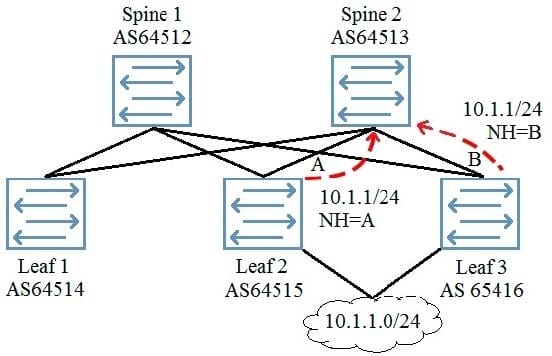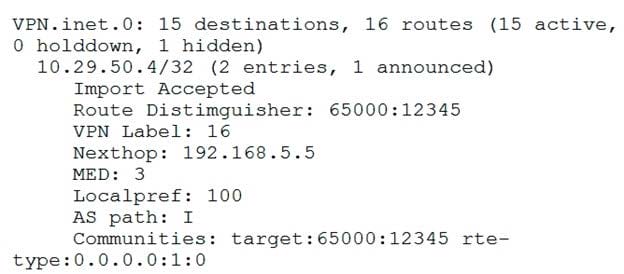Exam Details
Exam Code
:JN0-681Exam Name
:Data Center, Professional (JNCIP-DC)Certification
:Juniper CertificationsVendor
:JuniperTotal Questions
:65 Q&AsLast Updated
:Mar 25, 2025
Juniper Juniper Certifications JN0-681 Questions & Answers
-
Question 21:
You have deployed two data centers that require a Layer 2 stretch between host1 and host2.

Referring to the exhibit, what does a Layer 2 stretch require?
A. a VXLAN tunnel originating on the Super Spine Layer in DC1 to the Super Spine Layer in DC2.
B. a VXLAN tunnel originating on VTEP1 to VTEP2.
C. a VXLAN tunnel originating on the Spine Layer in DC1 to the Spine Layer in DC2.
D. a VPLS WAN connection between data centers.
-
Question 22:
Referring to the exhibit, each node in the IP fabric is peering to its directly attached neighbor using EBGP. Each node is peering using physical interface IP addresses. Leaf 2 and Leaf 3 are advertising the 10.1.1/24 network into EBGP. Spine 2 must be configured so that it can load-share traffic destined to the 10 1.1/24 network over both next-hop A and next-hop B.

Which two actions must be performed to accomplish this task? (Choose two.)
A. Use a load-balancing policy applied to the forwarding table.
B. Use multipath multiple-AS.
C. Use advertise-inactive.
D. Use multihop.
-
Question 23:
Which two statements describe EVPN-based VXLAN implementations? (Choose two.)
A. The movement of a virtual host requires a manual reconfiguration of the VTEP.
B. The movement of a virtual host results in the dynamic remapping of the VTEP.
C. MAC addresses are learned using multicast flooding.
D. MAC addresses are propagated using BGP updates.
-
Question 24:
You are troubleshooting an L3VPN that is part of an EVPN/MPLS DCI. You notice that the EVPN overlay BGP session toward 10.29.50.4 is unable to establish.

Why is the BGP session failing to establish?
A. The vrf-table-label value is not configured in the remote PE.
B. The route-distinguisher value on the local PE is incorrect.
C. There is no route for 192.168.5.5 in inet.3.
D. There is no route for 192.168.5.5 in VPN.inet.0.
-
Question 25:
You are building a new IP fabric data center underlay network and want to ensure predictable load-balancing behavior for traffic traversing the fabric.
What are two approaches you should take to satisfy the requirement in this scenario? (Choose two.)
A. Ensure that all uplinks are 40GbE.
B. Ensure that every leaf node has a link to every other leaf node.
C. Ensure that every leaf node has an uplink to every spine node.
D. Ensure that all spine devices are the same switch model.
-
Question 26:
You are asked to enable plug-and-play for future line card switches in an active VCF without making any future Junos configuration changes. You are also required to ensure that all new line cards are automatically upgraded to the correct Junos version without any manual intervention.
In this scenario, which two actions will accomplish this task? (Choose two.)
A. Ensure that the newly inserted line card's MAC addresses are present in the DHCP configuration for ZTP.
B. Configure the auto-sw-update parameter on the VCF before inserting new line cards.
C. Set the Virtual Chassis as pre-provisioned before the line cards are inserted.
D. Set the Virtual Chassis as auto-provisioned before the line cards are inserted.
-
Question 27:
Which two statements define the use of route targets and route distinguishers in an EVPN? (Choose two.)
A. Route targets ensure that routes from different clients remain unique within the data center domain.
B. Route targets identify the VRF into which the route should be placed.
C. Route distinguishers ensure that routes from different clients remain unique within the data center domain.
D. Route distinguishers identify the VRF into which the route should be placed.
-
Question 28:
Which two statements describe an IP fabric? (Choose two.)
A. Open standards allow for vendor interoperability.
B. Each leaf should have a connection to each spine.
C. xSTP protocols should be used to prevent loops.
D. Traffic should always follow a single path.
-
Question 29:
What is the purpose of the command shown in the exhibit?

A. to stop the transmission of transit multicast traffic when there are no interested receivers attached to a remote VTEP.
B. to disallow IGMP requests for the group 239.0.0.1 from hosts attached to the local VTEP.
C. to disable the multicast group 239.0.0.1 across the entire VXLAN.
D. to stop the reception of transit multicast traffic when there are no interested receivers attached to the local VTEP.
-
Question 30:
Which two combinations are supported when configuring a Virtual Chassis Fabric? (Choose two.)
A. two spine nodes and 28 leaf nodes
B. four spine nodes and 20 leaf nodes
C. four spine nodes with 16 leaf nodes
D. two spine nodes and 16 leaf nodes
Related Exams:
JN0-102
Internet Associate, Junos(JNCIA-Junos)JN0-104
Junos, Associate (JNCIA-Junos)JN0-105
Junos, Associate (JNCIA-Junos)JN0-1101
Juniper Networks Certified Design Associate (JNCDA)JN0-130
Juniper networks Certified internet specialist.e(jncis-e)JN0-1301
Data Center Design, Specialist (JNCDS-DC)JN0-1302
Data Center Design Specialist (JNCDS-DC)JN0-1331
Security Design, Specialist (JNCDS-SEC)JN0-1332
Security Design, Specialist (JNCDS-SEC)JN0-1361
Service Provider Design Specialist (JNCDS-SP)
Tips on How to Prepare for the Exams
Nowadays, the certification exams become more and more important and required by more and more enterprises when applying for a job. But how to prepare for the exam effectively? How to prepare for the exam in a short time with less efforts? How to get a ideal result and how to find the most reliable resources? Here on Vcedump.com, you will find all the answers. Vcedump.com provide not only Juniper exam questions, answers and explanations but also complete assistance on your exam preparation and certification application. If you are confused on your JN0-681 exam preparations and Juniper certification application, do not hesitate to visit our Vcedump.com to find your solutions here.